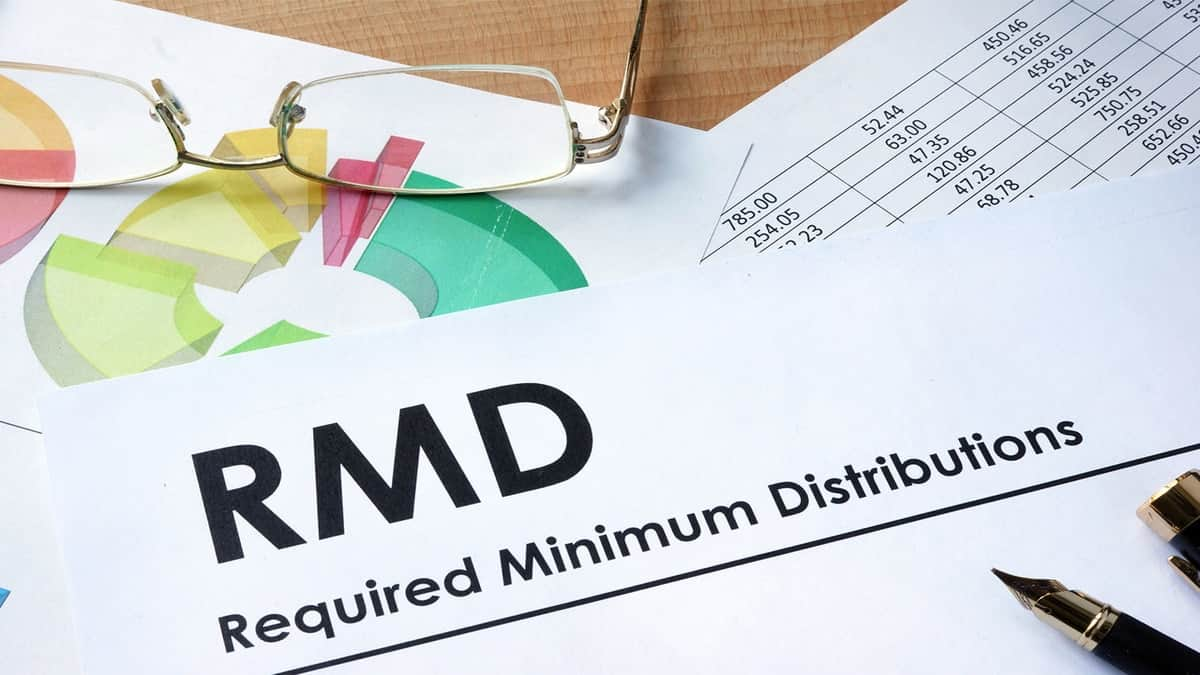RMD Calculator
Required Minimum Distribution or better known as the RMD speaks for itself. Since a person cannot keep retirement funds in a retirement account indefinitely, one must start making withdrawals from the account.

Contents
- Required Minimum Distribution (RMD) Calculator
- How to Calculate Required Minimum Distributions (RMDs)
- How to Delay RMD Deadlines
- What Retirement Accounts do RMDs Apply to?
- RMDs and Taxes
- Inherited 401k RMD Rules
- What type of retirement accounts require RMDs?
- When do I take my first RMD?
- How is my RMD calculated?
- Calculate Required Minimum Distributions
- IRA worksheet for married filing jointly if a spouse is the sole beneficiary and 10 or more years younger
- RMD Age Update
Required Minimum Distribution (RMD) Calculator
How to Calculate Required Minimum Distributions (RMDs)
As a taxpayer with retirement accounts, it is your responsibility to calculate your required minimum distribution (RMD). RMDs are calculated based on several factors, including age and the value of the accounts.
You can access the IRS calculation tables online. They are regularly revised to take into account changes in life expectancy.
How to Delay RMD Deadlines
Required Minimum Distributions (RMDs) are an integral part of retirement planning but can also be tedious. Delaying RMDs helps you reduce taxes and boost the income available from your accounts each year.
The Internal Revenue Service (IRS) has rules that permit some individuals to defer RMDs from 401(k) and other employer-sponsored retirement plans until after retirement – this is commonly referred to as the still-working exception. However, this exception only applies to workers who do not own more than 5% of their employer’s stock.
Business owners who own more than 5% of their company’s stock must begin taking Required Minimum Distributions (RMDs) at age 72. As such, many small business owners take their first RMD after retirement.
For some people, delaying their RMD until retirement may be the best option. However, if you are still determining if you can wait until then, it might be better to withdraw the full RMD from your accounts this year and take distributions out of a lower tax bracket next year.
What Retirement Accounts do RMDs Apply to?
RMDs (Required Minimum Distributions) (RMDs) apply to retirement accounts funded with tax-deferred contributions, such as traditional IRAs and 401(k)s). Please take these required minimum distributions by the deadline to avoid an IRS penalty.
You may postpone taking your first RMD until April 1 after reaching age 72 (72 if born in 2023 or later). However, this does not relieve you from taking another RMD by December 31 of that same year.
Your required minimum distribution amount for each year is calculated by dividing your total tax-deferred account balances by your age on the IRS uniform lifetime table, then subtracting its life expectancy factor from this total.
Once you know how much must be withheld each year, work with an Ameriprise financial advisor to craft a strategy that meets your RMD requirements and minimizes income taxes. For instance, part of your RMD can be donated directly to a qualified charity to reduce any tax bills associated with them.
Some exceptions to RMD rules may be beneficial for certain people. These include inherited IRAs, 403(b)s, and other qualified retirement accounts. But it’s always wise to consult your Ameriprise financial advisor before changing your retirement plan.
RMDs and Taxes
Required minimum distributions (RMDs) are the IRS’ way of ensuring you withdraw your tax-favored retirement account earnings by a certain age. The government will slap you with a 50% penalty if not taken.
Rules can be complex, and calculations depend on individual circumstances. Here’s how to get started:
Calculating your required minimum distribution (RMD), estimate how much money is in all tax-deferred accounts at the end of last year. Subtract this total by the IRS life expectancy factor associated with your age.
Once you know the amount to take out, work with a financial advisor to determine how to withdraw it, for instance, you could donate the RMD to charity instead of spending it.
Saving taxes and avoiding IRS penalties associated with taking too little out of your retirement account are great ways to reduce taxes and mitigate potential liabilities. Furthermore, if you can roll over an IRA or 401(k) into a Roth IRA, any tax-free income reduces the potential risk of penalties.
If you have multiple IRAs, calculate RMDs separately for each one. Otherwise, you could have many funds in various accounts that you aren’t required to withdraw.
Inherited 401k RMD Rules
Non-spouse beneficiaries of inherited 401k plans can take advantage of a special rule that allows them to “stretch” the distribution period over their life expectancy. While this option is less favorable than the 10-year rule, it still offers some flexibility.
Non-spouse beneficiaries of inherited 401k accounts are usually taxed as ordinary income, making them more vulnerable to an IRS audit if it is discovered that the account owner has artificially increased their retirement plan balances.
Non-spouse beneficiaries must begin taking RMDs by April 1 of the year following the account owner’s 70 1/2 birthday (or earlier if they died before 2020, or later if they didn’t reach 70 1/2 before then). Otherwise, a significant tax liability may arise.
However, only some have access to this option. Some employers can force beneficiaries to use a less favorable five-year rule instead. Therefore, if you’re a non-spouse beneficiary and wish to maximize your tax benefits and minimize your tax burden, consult an experienced tax professional for guidance.
What type of retirement accounts require RMDs?
RMDs (Required Minimum Distributions) are mandatory withdrawals from tax-favored retirement accounts such as traditional IRAs and employer-sponsored plans like 401(k)s that must be made starting at age 72. They play a significant role in your retirement income planning, having the potential to make or break your financial security in retirement.
Generally, the amount you must withdraw annually from an IRA or retirement plan depends on your life expectancy as determined by IRS life expectancy tables. To calculate how much is due each year, divide your account balance as of December 31 by the appropriate divisor found in the IRS life expectancy tables.
The IRS provides an easy-to-use RMD calculator that makes calculating your required minimum distribution amounts from IRAs, 401(k)s, and other retirement plans a breeze. The tool also offers helpful advice for making tax-efficient withdrawals from these accounts.
Multiple IRAs or 403(b) contracts can be combined and taken as one total RMD from all accounts. On the other hand, if your employer’s 401(k) requires taking RMDs from each account you own, each charge must be calculated separately and accepted in total each year.
When do I take my first RMD?
If you have a tax-deferred retirement account such as an IRA or 401k plan, you must begin taking required minimum distributions (RMDs) soon. This is essential because RMDs help determine how much money is left for living during retirement.
The IRS has provided tables calculating your Required Minimum Distribution (RMD). These calculations are based on your age and the balance in your retirement account at the end of each calendar year.
When determining when to take your first RMD, it’s important to consider financial goals and other elements, like how your retirement plan affects tax obligations. For instance, if you receive Social Security benefits, delaying the RMD until next year could help avoid a tax bill altogether.
However, it’s also worth noting that delaying your first RMD can work against you. If you postponed the distribution date by one year, then two distributions must be taken the following year–one for the year you delayed and one for when it usually falls on December 31. This “double” distribution increases taxable income and may place you into a higher tax bracket.
How is my RMD calculated?
RMDs, or Required Minimum Distributions, are the annual amounts you must withdraw from retirement accounts like traditional IRAs and 401(k) plans. The IRS enforces RMD rules for these tax-deferred accounts, which can substantially affect your taxes.
There are ways to minimize your tax obligations while still fulfilling RMDs. One strategy is donating your RMD as a qualified charitable distribution (QCD), which does not count as taxable income.
Another alternative is to convert your IRA to a Roth IRA, eliminating the need for RMDs. Both strategies offer tax benefits while simultaneously benefitting a nonprofit organization.
Based on your age and that of your spouse, you can use either the IRS Uniform Life Expectancy table or Joint Life and Last Survivor Expectancy table to calculate your Required Minimum Distributions (RMDs).
Additionally, the IRS allows you to postpone your first Required Minimum Distribution until April 1 of the year following your 73rd birthday. This can save money and prevent your account’s balance from getting too low.
Generally, most people aren’t required to take withdrawals until they reach the age of 72. The age limit was changed after the SECURE Act which was signed into law on December 20, 2024. Before the SECURE Act, the age limit was 70 and a half. The RMD refers to the amount that must be taken out from the retirement account every year.
The RMD amount must be withdrawn every year from the retirement account but the RMD amount is different for everyone. However, it applies to everyone who has the following types of retirement accounts.
- 401(k) plans
- 403(b) plans
- 457(b) plans
- SEP IRAs
- SIMPLE IRAs
- other defined contribution plans
- profit-sharing plans
- traditional IRAs
Calculate Required Minimum Distributions
The required minimum distribution is the balance of the account as of the end of the preceding calendar year divided by the distribution period from the IRS’ Uniform Lifetime Table.
You can figure out the RMD by taking a look at the RMD calculator worksheet.
The worksheet is different depending on a few things. If you’re married and your spouse is the sole beneficiary of your IRA and 10 or more years younger than you, use the following worksheet.
IRA worksheet for married filing jointly if a spouse is the sole beneficiary and 10 or more years younger
If not, you can use the following worksheet to calculate your required minimum distribution.
RMDs are mandatory withdrawals from tax-qualified retirement accounts such as IRAs and 401(k)s. They must be taken annually and are taxable as regular income. It is important to keep track of all your RMDs, as failing to take the required amount will result in a significant penalty. It is also a good idea to consult a tax specialist to double-check your administrators are calculating and distributing the correct amount (particularly in your first year).
RMD Age Update
The SECURE Act of 2022 changed the age at which RMDs must begin from 72 to 73 starting in 2023. This calculator follows those rules and uses the IRS life-expectancy tables to calculate your RMD.
Generally, an RMD is calculated by dividing the previous December 31 balance of your IRA or retirement plan account by the IRS life expectancy table for your age in that table’s year. These tables are listed in IRS Publication 590-B. The RMD is then multiplied by the applicable percentage rate.
The RMD is then added to your other sources of income, such as wages and Social Security benefits, and is reported on your tax return. You can use the money from your RMD for whatever you wish, including investing in a new business venture or giving it away to charity.





